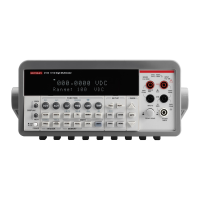5-8 Return to Section Topics 2100-900-01 Rev. D / September 2011
Section 5: Remote Interface Operations Model 2100 6 1/2-Digit Resolution Digital Multimeter User’s Manual
AVERage:AVERage?
AVERage:COUNt?
[CALCulate:]
NULL:OFFSet {<value>|MINimum|MAXimum}
NULL:OFFSet? [MINimum|MAXimum]
[CALCulate:]
LIMit:LOWer {<value>|MINimum|MAXimum}
LIMit:LOWer? [MINimum|MAXimum]
LIMit:UPPer {<value>|MINimum|MAXimum}
LIMit:UPPer? [MINimum|MAXimum]
[CALCulate:]
MXB:MMFactor {<value>|MINimum|MAXimum}
MXB:MMFactor? [MINimum|MAXimum]
MXB:MBFactor {<value>|MINimum|MAXimum}
MXB:MBFactor? [MINimum|MAXimum]
[CALCulate:]
DB:REFerence {<value>|MINimum|MAXimum}
DB:REFerence? [MINimum|MAXimum]
[CALCulate:]
DBM:REFerence {<value>|MINimum|MAXimum}
DBM:REFerence? [MINimum|MAXimum]
DATA:FEED RDG_STORE,{"CALCulate"|""}
DATA:FEED?
Triggering
The Model 2100 Digital Multimeter provides a variety of trigger operations: you can select a trigger
mode, a trigger source, and different trigger settings for individual measurements. Refer to
Figure
4-8 for a trigger operation flow chart.
Triggering from a remote interface is a multi-step sequence. You must first configure the
multimeter by choosing the desired function, range, and resolution. Specify the trigger source from
which the multimeter will accept the trigger. The multimeter can use an immediate internal trigger,
a software trigger from a remote interface, or an external trigger from the rear panel.
NOTE Before triggering, ensure that the multimeter is in the "wait-for-trigger" state; the
multimeter accepts a trigger only when it is in the "wait-for-trigger" state. When you have
finished configuring the multimeter and have selected a trigger source, place the
multimeter in the "wait-for-trigger" state by using either the INITiate, READ?, or
MEASure? commands (described earlier in this section).
Triggering commands
INITiate
READ?

